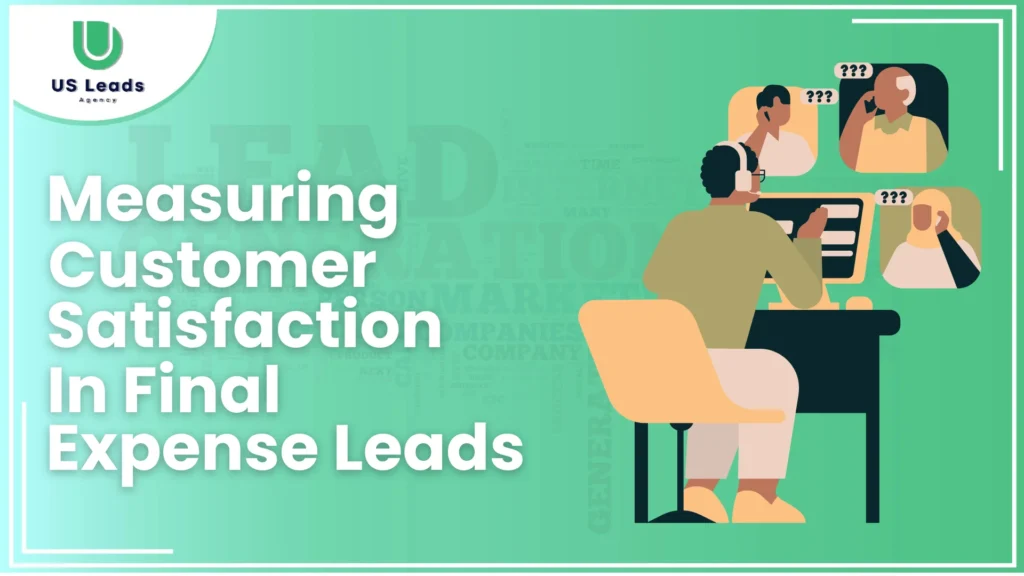
Customer satisfaction is the most critical factor in converting final expense leads into policyholders. According to HubSpot, 93% of customers are likely to buy again from companies with excellent service. In the emotionally sensitive world of final expense insurance, trust, clarity, and empathy drive buying decisions, not just pricing.
This article guides you about the importance of customer satisfaction for final expense lead conversions and breaks down proven strategies to measure, optimize, and leverage satisfaction data to convert more aged final expense leads, inbound final expense leads, and even $10 final expense leads effectively.
Key Takeaways:
- Use CSAT surveys and NPS to gather satisfaction feedback.
- Analyze behavioral and support metrics for conversion signals.
- Online reviews reveal brand perception and trust indicators.
- Personal interviews uncover emotional drivers of decision-making.
- Data-backed changes lead to better conversion of best final expense leads.
Table of Contents
Customer Satisfaction For Final Expense Lead Conversions | Complete Guide
1. Understand The Final Expense Customer Journey:
Mapping the journey helps measure satisfaction at every stage:
- Initial Interest: Click from ads (e.g., from Final expense leads Reddit)
- First Contact: Agent outreach
- Education Phase: Plan explanation
- Decision-Making: Comparing coverage
- Purchase: Final policy sign-up
- Post-Sale: Support and engagement.
Each phase provides touchpoints for feedback.
2. Use Surveys To Collect Feedback At Key Moments:
Pre-Sale Surveys:
Ask immediately after a lead interaction:
- Was our communication clear?
- Did the agent treat you with respect?
- Was the process easy?
Post-Sale Surveys:
Send right after a conversion:
- Was the experience satisfactory?
- Did you understand your policy?
- Would you recommend it to us?
Use Likert scales and optional open-ended sections.
3. Measure Net Promoter Score (NPS):
Ask:
“On a scale of 0–10, how likely are you to recommend our service?”
- Promoters (9–10) = Loyal and referral-ready
- Passives (7–8) = Neutral
- Detractors (0–6) = Dissatisfied
Track changes over time to assess improvement.
4. Monitor Customer Behavior Analytics:
Use behavior tracking tools to monitor:
- Time spent on landing pages
- Abandonment of lead forms
- Call duration with agents
- Funnel drop-off rates
This data reveals pain points in the process.
5. Track Customer Support Metrics:
After every interaction, ask:
“How satisfied were you with our assistance today?”
Monitor:
- First-contact resolution
- Number of interactions per issue
- Time to response
- Satisfaction score after support.
6. Analyze Online Reviews and Testimonials:
Scan platforms for Final expense leads reviews:
- Google Business
- Trustpilot
- BBB
Use sentiment analysis tools to group feedback by themes (trust, clarity, professionalism).
7. Interview Customers For Deeper Insight:
One-on-one interviews provide unmatched emotional context.
Ask:
- Why did you choose us?
- What was unclear?
- How did you feel after the purchase?
These answers refine agent training and scripts, especially for telesales.
8. Benchmark Against Industry Standards:
Target metrics:
- NPS: 40+
- Customer Satisfaction Score (CSAT): 80%+
- Live Support Response Time: Under 5 minutes
Compare your performance quarterly against these benchmarks.
9. Leverage Predictive Analytics:
Use tools to identify at-risk leads based on behavior:
- Predict churn from form drop-off
- Use email sentiment analysis
- Score leads for responsiveness
Apply this to improve outcomes for aged final expense leads and lower-tier final expense leads free.
10. Apply Feedback To Sales Process:
Customer satisfaction data should optimize:
- Landing page clarity
- Sales script tone and empathy
- Lead scoring
- Follow-up timing
- Plan presentation order
These refinements improve conversion rates, especially for best final expense leads for telesales.
Conclusion – Customer Satisfaction For Final Expense Lead Conversions:
Customer satisfaction isn’t a feel-good metric, it’s a conversion engine. In the final expense insurance space, it reduces churn, builds trust, and drives referrals. By tracking and applying insights at each customer journey stage, agencies can consistently convert exclusive, inbound, and aged final expense leads into lifelong policyholders.
FAQs:
Why is customer satisfaction important in final expense insurance?
It builds trust, reduces objections, and drives referrals for emotionally-driven sales.
How often should I measure customer satisfaction?
At every major stage, post-contact, after purchase, and after support events.
What is a good Net Promoter Score (NPS) in the insurance industry?
An NPS above 40 is considered excellent for insurance firms.
Can customer satisfaction really increase lead conversions?
Yes. Satisfied leads convert faster and refer others, improving ROI.
Where can I find honest final expense leads reviews?
Check platforms like Trustpilot, BBB, Facebook, and Reddit discussions.
